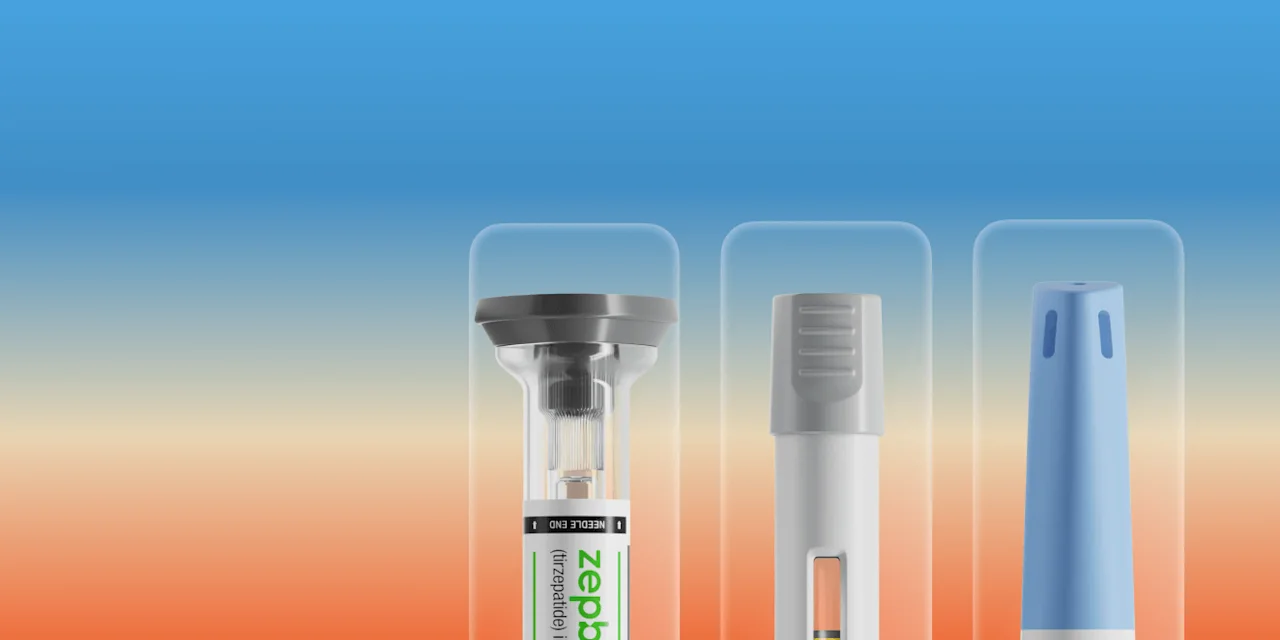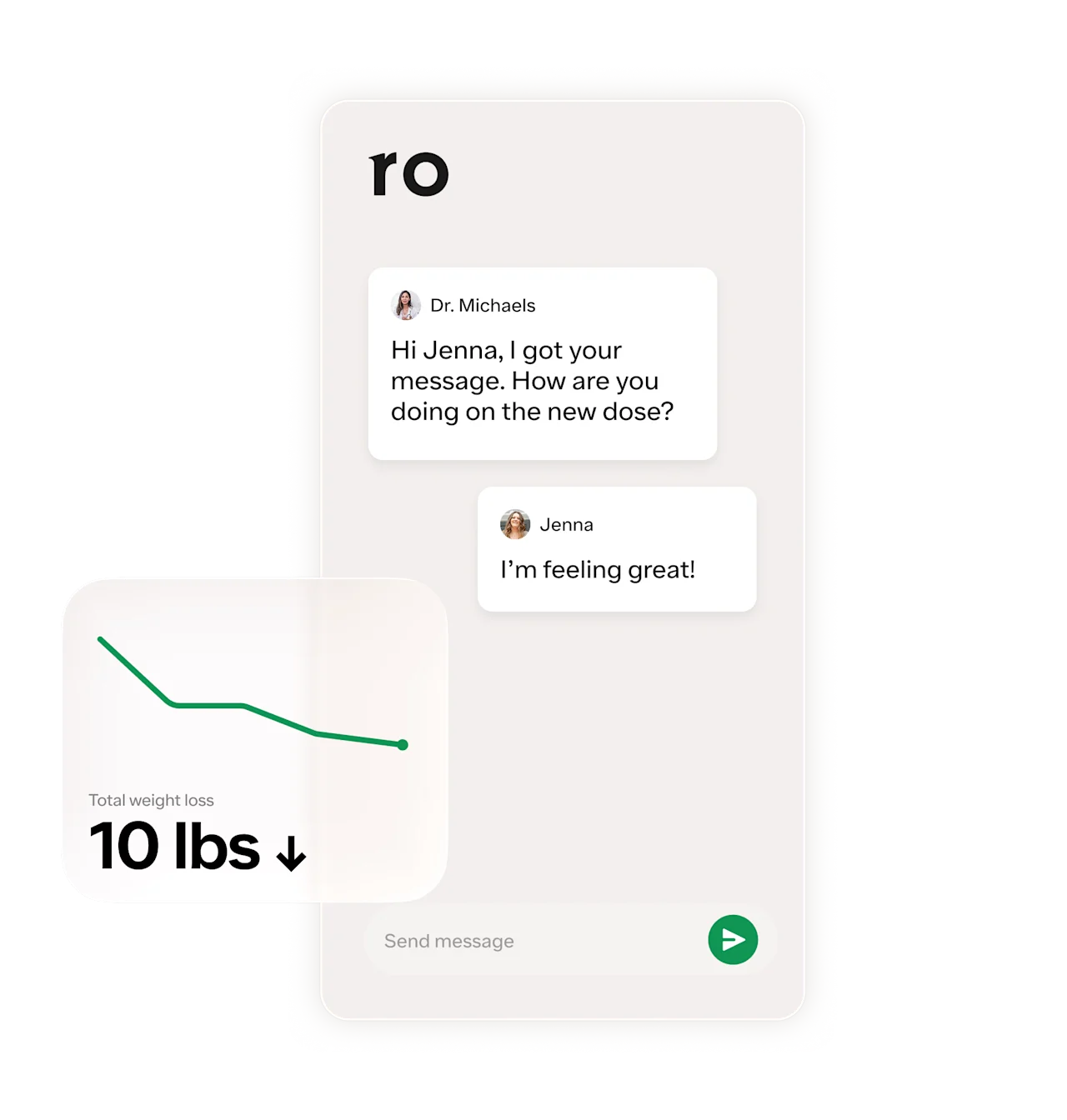Key takeaways
A new study suggests that semaglutide—the active ingredient in Ozempic and Wegovy—may affect a person’s taste perception, taste bud gene expression, and brain activity in response to sweet tastes.
People with type 2 diabetes or obesity—both conditions that semaglutide treats—have a lower sense of taste compared to people without those conditions, so they need to eat more to get the same level of pleasure from sweet foods.
Here's what we'll cover
Here's what we'll cover
Here's what we'll cover
Key takeaways
A new study suggests that semaglutide—the active ingredient in Ozempic and Wegovy—may affect a person’s taste perception, taste bud gene expression, and brain activity in response to sweet tastes.
People with type 2 diabetes or obesity—both conditions that semaglutide treats—have a lower sense of taste compared to people without those conditions, so they need to eat more to get the same level of pleasure from sweet foods.
When it comes to weight loss, we know that semaglutide works by slowing down digestion and reducing appetite, so people taking the medication tend to feel full sooner and eat less. But, a recent study suggests another mechanism may be at work: taste. Researchers found that semaglutide may influence taste sensitivity and could even alter how sweet tastes are processed in your brain. Read on to learn more about how these weight loss medications may affect your taste buds, too.
What is semaglutide?
Semaglutide is the active ingredient in the diabetes medication Ozempic and weight loss drug Wegovy. (Both medications are also approved to reduce cardiovascular risk in people with known heart disease and either type 2 diabetes or obesity.)
Semaglutide belongs to a category of prescription medications known as GLP-1s. Short for glucagon-like peptide-1, GLP-1 is a gut hormone your body creates after you eat to regulate your appetite and blood sugar levels. GLP-1 drugs like Ozempic and Wegovy work by mimicking this hormone. So do other drugs in the category, including Saxenda (liraglutide), Trulicity (dulaglutide), and Mounjaro and Zepbound (tirzepatide).
After you eat, these medications can help keep blood sugar levels in check. They also help with weight loss. Put simply, GLP-1s lower appetite and increase satiety (fullness), leading to weight loss. But that may not be the whole story.
Previous research has found that semaglutide also affects your cravings for certain foods. People taking the medication report having more control over their eating, and being less interested in high-fat, calorie-dense foods—as well as salty, spicy, dairy, and starchy foods. Additionally, animal studies have found that GLP-1 may impact areas of the brain involved in appetite regulation and reward perception. Now, a new study suggests an impact on taste perception as well.
Ozempic Important Safety Information: Read more about serious warnings and safety info.
Wegovy Important Safety Information: Read more about serious warnings and safety info.
Saxenda Important Safety Information: Read more about serious warnings and safety info.
Mounjaro Important Safety Information: Read more about serious warnings and safety info.
Zepbound Important Safety Information: Read more about serious warnings and safety info.
Can semaglutide (Ozempic, Wegovy) affect taste?
Semaglutide may affect taste perception, taste bud gene expression, and brain activity in response to sweet tastes, according to research findings presented at the Endocrine Society's annual meeting, ENDO 2024. In the study, the scientists observed the effects of semaglutide in a group of 30 women with obesity (average BMI of 36.4) over the course of 16 weeks. Half of the participants took a 1 milligram (mg) weekly dose of Ozempic, while the others took a placebo. The researchers looked at three aspects of taste, including:
Taste sensitivity: This was measured using strips that had concentrations of the four basic tastes: sweet, bitter, salty, and sour.
Taste bud gene expression: A tongue biopsy revealed how participants responded to taste at a genetic level.
Brain activity: Using MRIs, researchers observed how their brains responded to having a sweet solution dripped onto their tongue before and after eating a meal.
At the end of the study, the women taking semaglutide displayed an improved sensitivity to taste compared to those taking a placebo. Their tongue biopsies revealed that the genes involved in taste perception and taste bud renewal were more active. Their brains, especially the part of the brain called the angular gyrus, showed increased activity when tasting a sweet solution. Located in the parietal cortex, the angular gyrus is involved in a number of functions, including memory retrieval, semantic processing, and reasoning.
While these findings are exciting, the researchers did caveat that the study was small (only 30 people, all of whom were women), and that the response to taste in a study environment may not translate to a real-world environment. However, previous animal studies have reported similar findings: wild mice with a healthy GLP-1 receptor had a stronger response to sweet tastes than those missing the receptor.
It may not surprise you to learn that taste isn’t universal. Factors as wide-ranging as your age, your gender, whether you smoke or drink, your menstrual cycle (if you have one), and the medications you take can all impact your sense of taste. People perceive tastes differently, and that can affect the foods they gravitate towards, and how much of those foods they eat.
People with type 2 diabetes or obesity—both conditions that semaglutide treats—may have a lower sense of taste compared to people without those conditions. Obesity has been linked to changes in the feedback loop between your taste buds and your brain. And some research has found that as body mass index (BMI) increases, taste sensitivity decreases.
In particular, people with obesity may have a reduced sensitivity to sweet tastes. “People with obesity have a blunted response to sweets, so they need to eat more of it to get the same reward. They’re eating more, but they’re not getting as much pleasure from it as someone who is not obese,” shares Dr. Charlie Seltzer, MD, a board-certified physician in obesity medicine and internal medicine and a Certified Strength and Conditioning Specialist. While metabolism plays a role in weight gain or loss, he says, appetite and intake have a larger impact.
At the same time, people with obesity may find sweet-tasting food more desirable. This puts them in a tough spot when it comes to weight loss, since calorie-dense foods tend to be tastier. “Their receptors are more attracted to sweets and dense foods,” shares Dr. Dina Peralta-Reich, MD, a physician holding dual board certifications in Pediatrics and Obesity Medicine, and the founder and director of New York Weight Wellness Medicine. “They perceive tastes less intensely, but they have an elevated desire for high-calorie foods like pasta, pastries, breads, and creamy, heavy foods.”
So, what does this mean?
If taking GLP-1 drugs like semaglutide increases a person’s sensitivity to sweet tastes, as the research suggests, it may explain yet another way the drugs lead to weight loss. “When you have this increased sensitization from the GLP-1s, it drops your appetite, so you end up eating less and lose weight,” says Dr. Seltzer.
That increased sensitivity may extend to other foods as well, making them more pleasurable and enticing to people taking GLP-1s, says Dr. Peralta-Reich. “People with obesity on GLP-1s start to experience tastes more intensely, but not only for sweet and dense foods. It opens your horizons to different foods that you are more willing to eat.”
While this is just one small study, it adds to a body of research that suggests our sense of taste plays a role in weight gain or loss. Previous studies have suggested that some aspects of obesity, including taste and reward, can be reversed. People who exercise more often—which is recommended when taking semaglutide—tend to rate sweet tastes as more intense according to a small study in men, so they may consume fewer calories.
The bottom line on semaglutide and taste
Semaglutide, the active ingredient in Wegovy and Ozempic, has been hailed for its ability to treat type 2 diabetes, produce weight loss, and reduce cardiovascular risk. This latest study suggests semaglutide may also improve taste sensitivity in adults with obesity, especially for sweet tastes, but more research is needed to confirm these findings.
If you’re interested in semaglutide, a Ro provider can discuss your goals and help you determine whether weight loss medication may be right for you.
DISCLAIMER
If you have any medical questions or concerns, please talk to your healthcare provider. The articles on Health Guide are underpinned by peer-reviewed research and information drawn from medical societies and governmental agencies. However, they are not a substitute for professional medical advice, diagnosis, or treatment.
References
Berthoud, H. R. & Zheng, H. (2012). Modulation of taste responsiveness and food preference by obesity and weight loss. Physiology & Behavior, 107(4), 527–532. doi:10.1016/j.physbeh.2012.04.004. Retrieved from https://www.ncbi.nlm.nih.gov/pmc/articles/PMC3406227/
Blundell, J., Finlayson, G., Axelsen, M., et al. (2017). Effects of once-weekly semaglutide on appetite, energy intake, control of eating, food preference and body weight in subjects with obesity. Diabetes, Obesity & Metabolism, 19(9), 1242–1251. doi:10.1111/dom.12932. Retrieved from https://www.ncbi.nlm.nih.gov/pmc/articles/PMC5573908/
Chao, A. M., Tronieri, J. S., Amaro, A., et al. (2022). Clinical Insight on Semaglutide for Chronic Weight Management in Adults: Patient Selection and Special Considerations. Drug Design, Development and Therapy, 16, 4449–4461. doi:10.2147/DDDT.S365416. Retrieved from https://www.ncbi.nlm.nih.gov/pmc/articles/PMC9807016/
Chéruel, F., Jarlier, M., & Sancho-Garnier, H. (2017). Effect of cigarette smoke on gustatory sensitivity, evaluation of the deficit and of the recovery time-course after smoking cessation. Tobacco Induced Diseases, 15, 15. doi:10.1186/s12971-017-0120-4. Retrieved from https://www.ncbi.nlm.nih.gov/pmc/articles/PMC5329949/
Costanzo, A. (2024). Temporal patterns in taste sensitivity. Nutrition Reviews, 82(6), 831–847. doi:10.1093/nutrit/nuad097. Retrieved from https://www.ncbi.nlm.nih.gov/pmc/articles/PMC11082591/
Dickson, S. L., Shirazi, R. H., Hansson, C., et al. (2012). The glucagon-like peptide 1 (GLP-1) analogue, exendin-4, decreases the rewarding value of food: a new role for mesolimbic GLP-1 receptors. The Journal of Neuroscience: the Official Journal of the Society for Neuroscience, 32(14), 4812–4820. doi:10.1523/JNEUROSCI.6326-11.2012. Retrieved from https://www.ncbi.nlm.nih.gov/pmc/articles/PMC6620919/
Endocrine Society. (2024). GLP-1 has the power to change taste sensitivity in women with obesity. Retrieved from https://www.endocrine.org/news-and-advocacy/news-room/2024/endo-2024-press-jensterle-sever
Faria, A., Allen, A. H., Fox, N., et al. (2021). The public health burden of obstructive sleep apnea. Sleep Science (Sao Paulo, Brazil), 14(3), 257–265. doi:10.5935/1984-0063.20200111. Retrieved from https://www.ncbi.nlm.nih.gov/pmc/articles/PMC8848533/
Fathi, M., Javid, A. Z., & Mansoori, A. (2023). Effects of weight change on taste function; a systematic review. Nutrition Journal, 22(1), 22. doi:10.1186/s12937-023-00850-z. Retrieved from https://www.ncbi.nlm.nih.gov/pmc/articles/PMC10165840/
Feeney, E. L., Leacy, L., O'Kelly, M., et al. (2019). Sweet and Umami Taste Perception Differs with Habitual Exercise in Males. Nutrients, 11(1), 155. doi:10.3390/nu11010155. Retrieved from https://www.ncbi.nlm.nih.gov/pmc/articles/PMC6357145/
Garvey, W. T., Batterham, R. L., Bhatta, M., et al. (2022). Two-year effects of semaglutide in adults with overweight or obesity: the STEP 5 trial. Nature Medicine, 28(10), 2083–2091. doi:10.1038/s41591-022-02026-4 Retrieved from https://www.ncbi.nlm.nih.gov/pmc/articles/PMC9556320/
Jiang, R. S. & Chiang, Y. F. (2023). Effect of Age and Gender on Taste Function as Measured by the Waterless Empirical Taste Test. Diagnostics (Basel, Switzerland), 13(20), 3172. doi:10.3390/diagnostics13203172. Retrieved from https://www.ncbi.nlm.nih.gov/pmc/articles/PMC10605808/
Pugnaloni, S., Alia, S., Mancini, M., et al. (2020). A Study on the Relationship between Type 2 Diabetes and Taste Function in Patients with Good Glycemic Control. Nutrients, 12(4), 1112. doi:10.3390/nu12041112. Retrieved from https://www.ncbi.nlm.nih.gov/pmc/articles/PMC7230282/
Rawal, S., Hoffman, H. J., Bainbridge, K. E., et al. (2016). Prevalence and Risk Factors of Self-Reported Smell and Taste Alterations: Results from the 2011-2012 US National Health and Nutrition Examination Survey (NHANES). Chemical Senses, 41(1), 69–76. doi:10.1093/chemse/bjv057. Retrieved from https://www.ncbi.nlm.nih.gov/pmc/articles/PMC4715252/
Rohde, K., Schamarek, I., & Blüher, M. (2020). Consequences of Obesity on the Sense of Taste: Taste Buds as Treatment Targets?. Diabetes & Metabolism Journal, 44(4), 509–528. doi:10.4093/dmj.2020.0058. Retrieved from https://www.ncbi.nlm.nih.gov/pmc/articles/PMC7453985/
Sartor, F., Donaldson, L. F., Markland, D. A., et al. (2011). Taste perception and implicit attitude toward sweet related to body mass index and soft drink supplementation. Appetite, 57(1), 237–246. doi:10.1016/j.appet.2011.05.107. Retrieved from https://www.sciencedirect.com/science/article/abs/pii/S0195666311002649?via%3Dihub
Schiffman, S. S. (2018). Influence of medications on taste and smell. World Journal of Otorhinolaryngology - Head and Neck Surgery, 4(1), 84–91. doi:10.1016/j.wjorl.2018.02.005. Retrieved from https://www.ncbi.nlm.nih.gov/pmc/articles/PMC6051304/=
Seghier, M. L. (2013). The angular gyrus: multiple functions and multiple subdivisions. The Neuroscientist: A Review Journal Bringing Neurobiology, Neurology and Psychiatry, 19(1), 43–61. doi:10.1177/1073858412440596. Retrieved from https://www.ncbi.nlm.nih.gov/pmc/articles/PMC4107834/
Stanić, Ž., Pribisalić, A., Bošković, M., et al. (2021). Does Each Menstrual Cycle Elicit a Distinct Effect on Olfactory and Gustatory Perception?. Nutrients, 13(8), 2509. doi:10.3390/nu13082509. Retrieved from https://www.ncbi.nlm.nih.gov/pmc/articles/PMC8401541/
Takai, S., Yasumatsu, K., Inoue, M., et al. (2015). Glucagon-like peptide-1 is specifically involved in sweet taste transmission. FASEB Journal: Official Publication of the Federation of American Societies for Experimental Biology, 29(6), 2268–2280. doi:10.1096/fj.14-265355. Retrieved from https://www.ncbi.nlm.nih.gov/pmc/articles/PMC4763871/
Vignini, A., Borroni, F., Sabbatinelli, J., et al. (2019). General Decrease of Taste Sensitivity Is Related to Increase of BMI: A Simple Method to Monitor Eating Behavior. Disease Markers, 2019, 2978026. doi:10.1155/2019/2978026. Retrieved from https://www.ncbi.nlm.nih.gov/pmc/articles/PMC6476129/
Wharton, S., Batterham, R. L., Bhatta, M., et al. (2023). Two-year effect of semaglutide 2.4 mg on control of eating in adults with overweight/obesity: STEP 5. Obesity (Silver Spring, Md.), 31(3), 703–715. doi:10.1002/oby.23673. Retrieved from https://onlinelibrary.wiley.com/doi/10.1002/oby.23673













